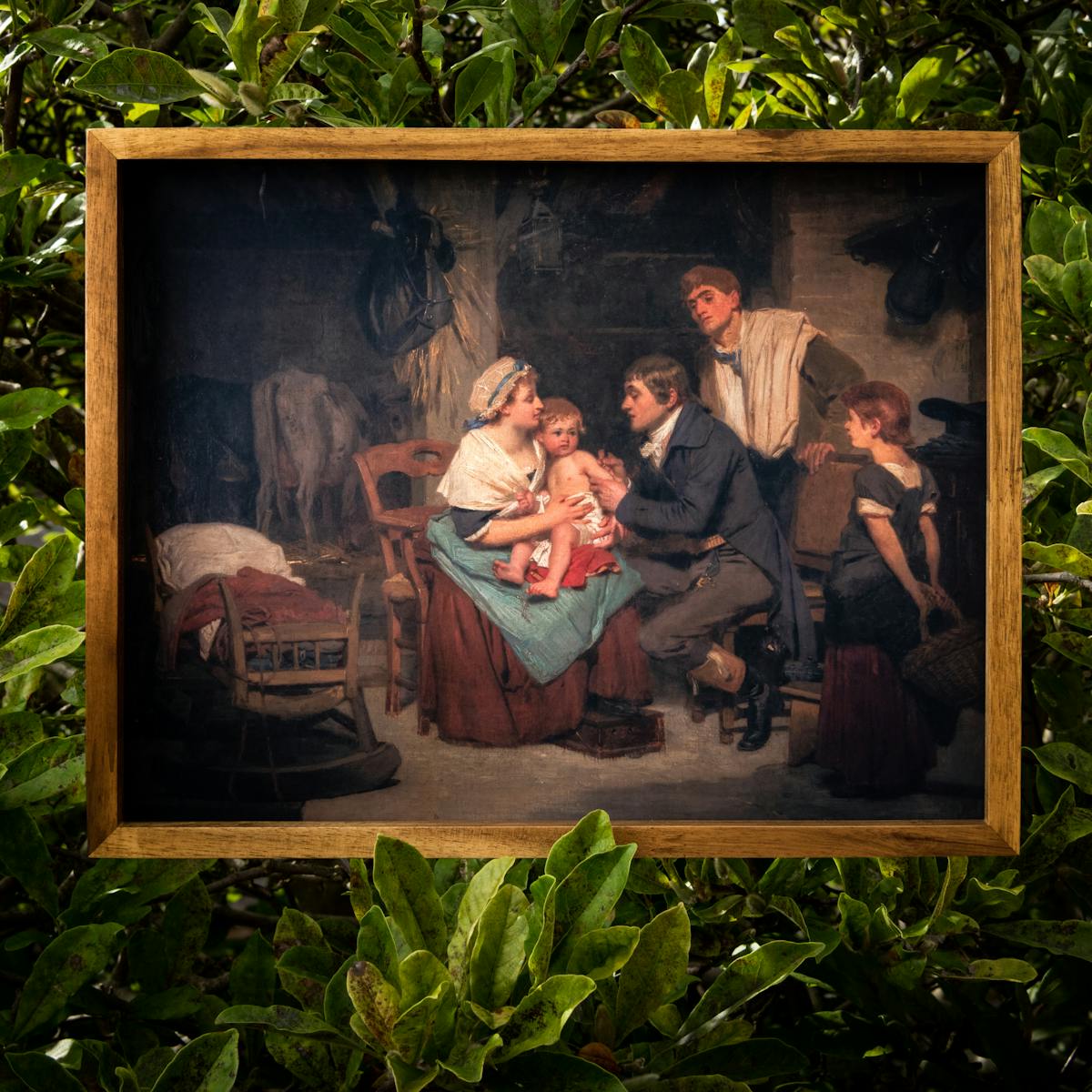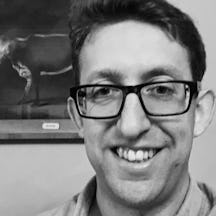The extraordinary medical legacy of Edward Jenner, the father of modern vaccination, has recently been brought into sharp focus. As nations campaign together for a free, universally accessible Covid-19 vaccine, Jenner expert Owen Gower reminds us of the doctor’s skill, enterprise and vision.
We all think we know the story of Edward Jenner, the country doctor who pioneered vaccination. The legend usually repeated is that Jenner, a family doctor from Gloucestershire, had observed that milkmaids working in the countryside around his hometown of Berkeley had remarkably clear complexions and were never afflicted by the scars of the feared disease smallpox. When he asked about this, he was told that they had all contracted cowpox in the course of their work and it was this that protected them from smallpox.
Jenner decided to try and experiment, and when Sarah Nelmes consulted him about the blisters she had acquired after milking a cow named Blossom, the doctor acted quickly. Using pus from Nelmes’s lesions, he deliberately infected James Phipps, the eight-year-old son of his gardener, first with cowpox and, later, with smallpox. To everyone’s relief, James did not contract smallpox. Jenner’s theory had been correct and vaccination was born.
Edward Jenner wanted vaccination to be free at the point of delivery ... available to everyone, no matter who they were or where they were from.
However, what is often forgotten is the rigorous scientific method behind Jenner’s experiment. For some years prior to this first vaccination in 1796 he had been gathering evidence supporting the theory that those who had once contracted cowpox were immune from smallpox. But his evidence was predominantly anecdotal and required scrutiny in the form of clinical trials.
A carefully considered clinical trial
This is how, on 14 May 1796, he came to take fluid from a cowpox blister on Nelmes’s hand and scratch it onto the skin of James Phipps, who had previously had neither cowpox nor smallpox. As expected, Phipps contracted cowpox and, once his fever subsided, Jenner then attempted to inoculate him using live smallpox.
This technique, also known as variolation, involved deliberately infecting a patient with a mild dose of smallpox in the expectation that it would provide protection from a more severe infection. It had long been practised in China, India, the Ottoman Empire, parts of Africa, and even Pembrokeshire, and had gained popularity in Western medicine after 1721, when it was championed by Lady Mary Wortley Montagu. Lady Mary had arranged for her children to be variolated after witnessing the practice in Turkey, and soon persuaded Caroline, Princess of Wales, to have her own children inoculated.
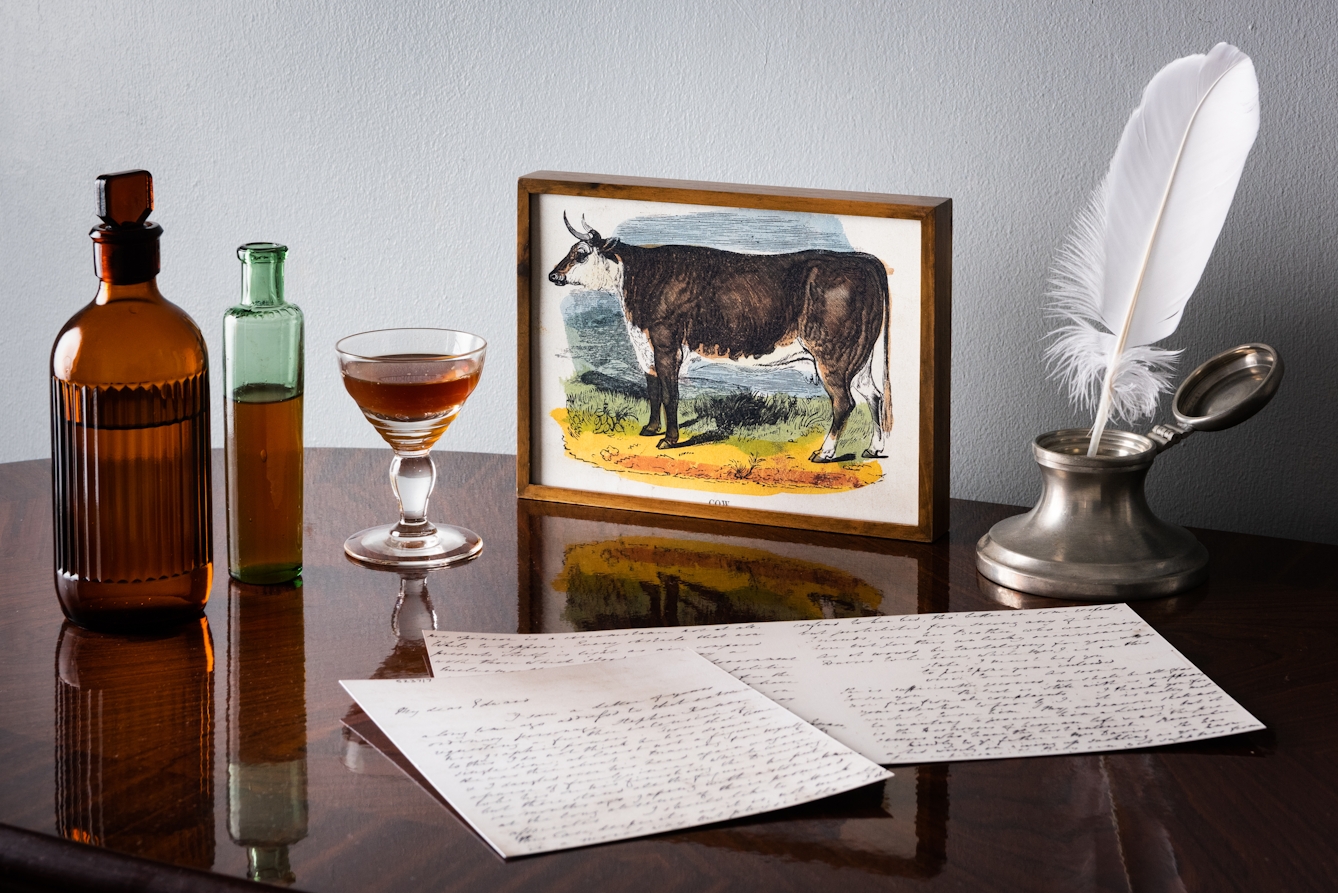
Jenner once wrote, “On average I am at least six hours daily with my pen in my hand bending over writing paper till I am grown as crocked as a cow’s horn and tawny as whey butter.”
Through modern eyes we might be taken aback by the ethical implications of deliberately infecting a child with smallpox; however, at the time the technique was considered to be the “gold standard” for artificially inducing immunity. Infection with the mild disease cowpox was perhaps more controversial, but Jenner’s theory looked to be correct when, despite exposure to the deadly virus, Phipps did not contract smallpox.
Some months later, Jenner attempted to inoculate Phipps with smallpox again, but to no effect, and then tried the same experiment on numerous others.
The first free vaccination clinic
Jenner’s trials were controlled, repeatable and, crucially, widely disseminated through his 1798 publication ‘An Inquiry Into the Causes and Effects of the Variolæ Vaccinæ’. Having shown that cowpox could protect against smallpox, Jenner devoted the rest of his life to telling the world about vaccination and how to perform it safely and effectively.
In the garden of his house in Berkeley, Gloucestershire, Jenner turned a rustic, thatched summerhouse into the world’s first free vaccination clinic. There he ensured that this life-saving medical intervention was available on the basis of need, rather than ability to pay. Many consider the Temple of Vaccinia, the grand name given by Jenner to this building, to be a symbol not just of hope in the fight against disease but of the principles and values of a later free public health service: the National Health Service.
John Baron, Edward Jenner’s biographer, wrote that “the discovery of vaccination, though pregnant with consequences, calculated from their magnitude to dazzle and bewilder the strongest intellect, was ushered into the world with singular modesty and humility”. And so it was that Jenner, without fanfare or ceremony, made his research on vaccination against smallpox freely available to the world.
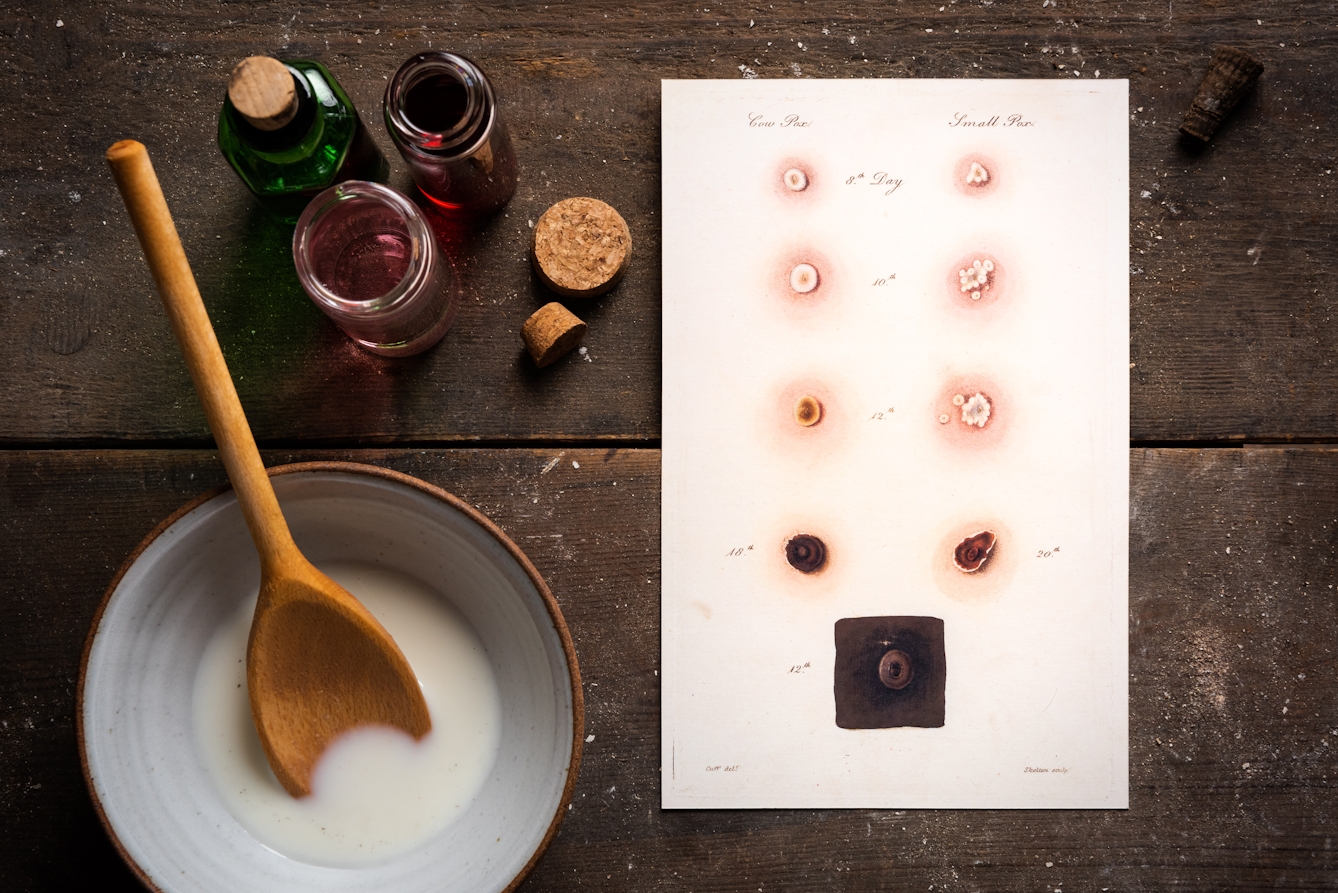
Coloured etching showing a close-up of the various stages of cowpox and smallpox over a number of days, from a publication by Jenner and William Woodville, 1800.
Jenner did not seek to profit from his work and discouraged others from doing the same. If anything, Jenner’s own income and medical practice suffered from the long hours he invested corresponding with those who were interested in adopting vaccination. He once wrote, “On average I am at least six hours daily with my pen in my hand bending over writing paper till I am grown as crocked as a cow’s horn and tawny as whey butter.”
At the heart of Jenner’s commitment to free access for all was his practice of opening his garden once a week so that the poor of the local area could be vaccinated.
From cowpox to Covid-19
Jenner’s tireless work to share news of vaccination was grounded in his own deep-seated compassion and desire to bring about a world free of smallpox. The fact that Jenner rarely travelled, preferring home comforts to a life on the road performing mass vaccinations, does not contradict these values. Jenner was, first and foremost, a community doctor.
In 1804 his friend W J Joyce observed, “The Doctor very well understands the art of dealing with their prejudices and it gave me great pleasure to observe the gentle and effectual manner with which he endeavoured to soothe their mind.” Jenner knew his patients and understood that they might have concerns about this new practice. That they consented to receive vaccination illustrates their level of trust in him.
Jenner primarily vaccinated within his normal practice area and taught others how to do the same in their own communities. This method of working perpetuated even to the final days of the World Health Organisation Smallpox Eradication Programme of 1966–80, when an international team of medics supported local healthcare workers to ensure vaccination was accepted in areas where people remained unprotected.
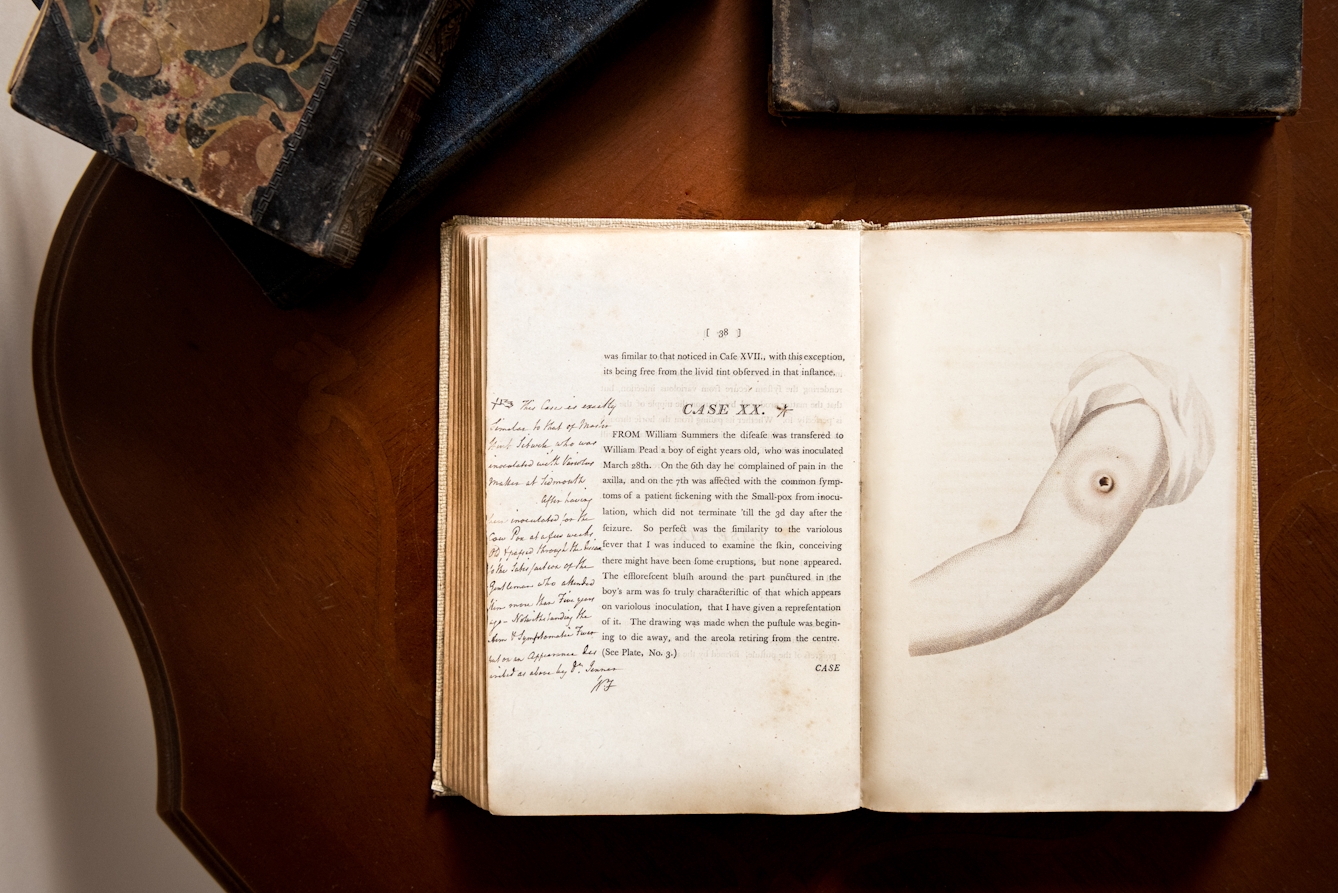
‘An inquiry into the causes and effects of the variolæ vaccinæ’ by Jenner, 1798.
Edward Jenner wanted vaccination to be free at the point of delivery, carefully explained by trusted and trained local healthcare workers, and available to everyone, no matter who they were or where they were from. He considered himself the “Vaccine Clerk to the World” and was not interested in geopolitical divides, for “the Sciences are never at War” and he knew that it would require an international effort to realise his dream of the global eradication of smallpox.
Jenner’s willingness to teach anyone to vaccinate contributed to the prompt uptake of this new practice throughout the world and was rewarded with international recognition and respect. In 1807, with Britain and France locked in conflict, Jenner petitioned Napoleon for the release of two friends who were being held as prisoners of war. Napoleon was minded to dismiss the request until his wife Joséphine insisted he look again at who it was from. “What that man asks is not to be refused” came the now famous reply from Napoleon.
Today, as we face a new disease in the form of Covid-19, more than 140 leaders around the world have called for a people’s patent-free vaccine. Discussions focus on equitable access, treatment focused on need, rather than ability to pay, and a method of distribution that is both rapid and fair.
In an open letter coordinated by UNAIDS (the Joint United Nations Programme on HIV/AIDS) and Oxfam, signatories called on governments and international partners to “unite around a global guarantee which ensures that, when a safe and effective vaccine is developed, it is produced rapidly at scale and made available for all people, in all countries, free of charge”.
And if all that sounds familiar, it should. These ideas are not new: they are Edward Jenner’s founding principles of vaccination.
About the contributors
Owen Gower
Owen Gower is Museum Manager at Dr Jenner’s House, the former home of vaccine pioneer Edward Jenner. He regularly speaks and participates in interviews about Edward Jenner, the history of smallpox and the development of vaccination.
Steven Pocock
Steven is a photographer at Wellcome. His photography takes inspiration from the museum’s rich and varied collections. He enjoys collaborating on creative projects and taking them to imaginative places.
